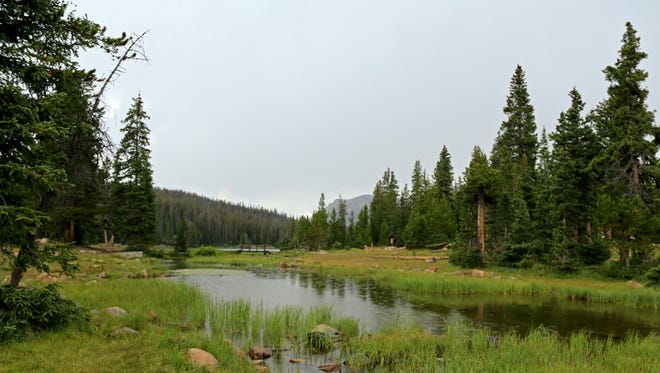Local weather change may hit Colorado River onerous

As a part of this new water sequence, every Friday (Saturday in print) we can be addressing a brand new subject that’s related to water safety in Iron and Washington counties. Verify again every week for updates on ongoing water points, interviews with consultants, and explorations of how we will guarantee a greater water future for the rising communities in southwestern Utah.
Harnessing ever-increasing computing capabilities, a brand new study has analyzed streamflow within the Colorado River Basin at a finer, extra zoomed-in scale than has beforehand been attainable. And what they discovered will not be nice information for the 40 million individuals who at present depend on Colorado River water.
About 85 p.c of Colorado River water originates from snowpack and rainfall within the river’s headwaters area on the west slope of Colorado’s Rocky Mountains. From there, it continues downstream to quench the thirst of cities like Las Vegas, Phoenix and, if the Lake Powell Pipeline is constructed, St. George. However earlier than it trickles down the mountainous slopes and leads to the river, a few of that water is slurped up by high-alpine evergreen forests.
Dheeraad ah:The Water Tap: Getting up to speed on the Lake Powell Pipeline project
The scientists discovered that, by shrinking the scale of the map grid used to know and summarize water dynamics within the Colorado’s headwaters area, they had been capable of seize extra of the environmental nuance of how a mountainous panorama influences the quantity of water that finally ends up flowing downstream. Their findings, published online in late July within the journal Environmental Analysis Letters, recommend that earlier fashions utilizing coarser map grids might have oversimplified the position of evergreen forests on excessive alpine slopes and underestimated how they may reply to local weather change.
“The fashions at present used to foretell future water provide for the southwest U.S. are primarily based on these very massive grids that simplify the mountains,” mentioned Lauren Foster, a hydrologist with an environmental threat evaluation group in Colorado, Neptune and Company, and lead creator on the analysis paper. “However there is a particular band of elevation the place the forest may be very delicate to rising temperatures, and that band will get oversimplified with these bigger grids.”

Simply as people are inclined to sweat extra and must drink extra water on hotter summer time days, bushes additionally lose water to the air via what known as evapotranspiration and should take up extra water from the bottom to make up for that loss when temperatures rise. That is very true for high-altitude forests which can be tailored to colder circumstances.
What got here into focus for these scientists by zooming in on forest patches is that, because the local weather warms and bushes want to soak up extra water to counteract rising evaporative loss, the quantity of water left over to circulation downriver will drop by 4 p.c greater than what earlier fashions have calculated.
“That 4 p.c distinction might appear to be a small quantity,” mentioned Foster. “However should you extrapolate that throughout all the Rockies, it is really an enormous quantity of water for the Colorado River. It might be one factor if the present fashions had been maybe underestimating our future water provide as a result of then you definitely’d be making ready for a future with extra water. However the truth that they’re overestimating, it would imply that we’ve much less water than we expect within the subsequent 50 years.”
Dheeraad ah:The Water Tap: A new weekly series about water issues in southwestern Utah
This evergreen impact will not be restricted to the Colorado River Basin. The identical discovering could be related, mentioned Foster, to any river sourced from mountain headwaters. With the western U.S. anticipated to endure warming and drying results below future local weather change situations, this discovering that bushes haven’t been absolutely accounted for by earlier fashions may forecast widespread water shortages as crops scuffling with a shifting atmosphere compete for his or her share.

However should you’re pondering this can be a silver lining to the truth that this summer time has seen tons of of hundreds of acres of western forests go up in smoke, suppose once more. With out forests to shade the mountain slopes, sluggish snowmelt, and root soil in place, our rivers could be in even worse form.
“What we have to do is begin accounting for that larger evaporation flux that we all know is occurring as a result of once we do an in depth research, we see it,” mentioned Foster. “We have to begin accounting for that impact in our waters once we predict provide below local weather change.”
Dheeraad ah:The Water Tap: Our thirst for beef may be harming fish, new research finds
Sadly, Brian Richter, president of Sustainable Waters, a world water training group, mentioned he sees science like this all too typically get ignored. He learn Foster’s research and referred to as it “sound science with worse information.” He thinks the research provides a fuller rationalization of why local weather warming is having a unfavourable impression on the native water programs. However he’s not hopeful that it’s going to encourage changes in municipal water planning.
“I don’t suppose that the water managers and the political decision-makers within the Colorado River Basin are paying ample consideration to what the local weather science is telling us,” Richter mentioned. “I feel the results of this local weather science for water provides within the Colorado River is far more severe than they’re main us to consider. Till they start to take this info critically and embrace it of their projections of provides and calls for for water sooner or later, they’re not going to be giving us the complete and trustworthy image.”
It’s, mentioned Richter, as much as us to demand that present water science be factored in to assembly future water wants.
Joan Meiners is an Surroundings Reporter for The Spectrum & Day by day Information via the Report for America initiative by The GroundTruth Mission. Comply with her on Twitter at @beecycles or electronic mail her at jmeiners@thespectrum.com.
 IVIGA Tap Supplier Warshada
IVIGA Tap Supplier Warshada
